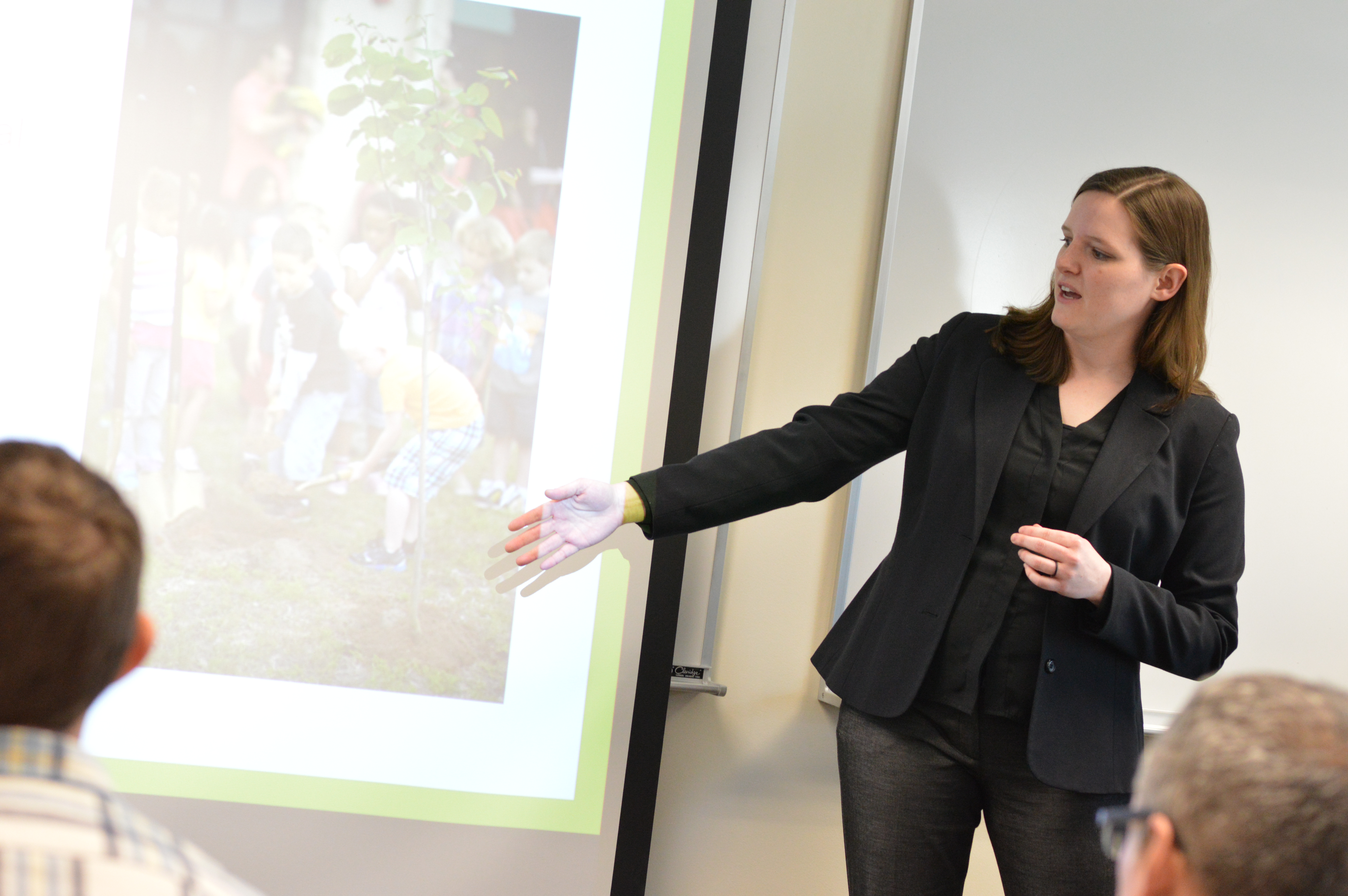
It took the students in the Greenspace and Urban Forestry Management class the entire semester to complete the 104-page Street Tree Master Plan for Lincoln, Nebraska, but when the Lincoln Parks and Recreation officials walked out of Hardin Hall on April 19 with the bound document in hand, they walked out with something worth more than $50,000.
“That’s the value,” said Lynn Johnson, Lincoln Parks director, “and at very little cost to us: Just staff time to be here today.”
To pay a professional team to write such a document would cost anywhere between $50,000 and $100,000, said Eric North, assistant professor of practice, who’s building the School of Natural Resources community and regional forestry program. And every suggestion in the document was based on science.
“Parts may seem untenable,” he told city representatives who attended the presentation. “But this wasn’t just academic information. These are all policies other cities have implemented, and they did not accomplish it all in one year.”
The project
When classes started the second week of January, the students in the capstone course, NRES 457, were told every assignment for the next 14 weeks would feed into one, massive undertaking: to scientifically research and write a planning document guiding the management of the city’s urban street trees.
When presenting their final product, the students touted the economic benefit of the city’s 120,000 trees — nearly $12 million dollars per year ― and they highlighted city programs designed to boost support of the city’s tree canopy, such as the $2 tree voucher program included in Lincoln Electric bills. But they also found the weak links in the current management process: The lack of an EAB response plan, staggered planting, or regular pruning cycles.
They pushed the mantra, “The right tree, in the right place, reduces maintenance and realizes benefits over time.”
And they recommended risk assessments, clearer tree ordinance language, preferred tree species planting lists and public outreach efforts.
“Presenting our plan to that many professionals was seriously a privilege,” said Erin Chambers, Department of Agronomy and Horticulture student. “Lynn Johnson and Lorri Grueber (Lincoln’s Community Outreach Forester) where there, and we couldn’t have written a solid plan without all the help they gave us during the semester.
“The crazy thing, though, is that we not only had people from Lincoln Parks & Recreation, but also people from the university, the Arbor Day Foundation and the Nebraska Forest Service. They had fantastic questions and feedback for us afterward. It’s a great feeling when you go into something nervous but come out inspired and motivated.”
The students, from SNR, agronomy and horticulture, landscape architecture and community and regional planning departments, gained key, resume-building experience through the process.
“(Before this class), I had never interacted with city personnel or much of the city documents, such as the municipal code rules or regulations,” said Tristan Mahler, a fisheries and wildlife major. “This class incorporated all the knowledge that I had learned in Eric's other classes ― from applying skills I learned in tree biology, to performing an inventory analysis exercise in Lincoln using my knowledge from dendro (or tree identification).”
“I’m confident (this class) will have prepared me for any future career I pursue,” he said.
In addition to growing her appreciation and love for trees, Chambers said the project opened her eyes to the importance of community engagement. She’ll walk away looking at how she can contribute to growing citizen engagement in tree care cross the city.
“It’s super important for Lincoln to have sufficient staffing and funds to manage its trees, but if citizens aren’t involved in things like tree care, education, fundraising, and garnering support for parks, trails, and trees, the forest really suffers,” she said. “I recognize more than ever that it’s up to us, as residents and constituents, to promote the things we believe are important and vote for legislators who make those things a priority – and, when we see a need, work to address it!”
Future collaboration
Next year’s class won’t tackle the same project, North said, but could take on writing a planning document for a different city or a difference aspect of Lincoln’s urban canopy, such as parks trees.
The door is open at Lincoln Parks for future collaboration. Lorri Grueber, community operations forester, invited the students to tag along with city foresters and arborists for a day, and Johnson plans to the completed document as a persuasion tool during city budget talks.
“It would be dreamy to implement some of these ordinance (recommendations),” Grueber said. “We have a lot of work to do.”
Shawna Richter-Ryerson, Natural Resources